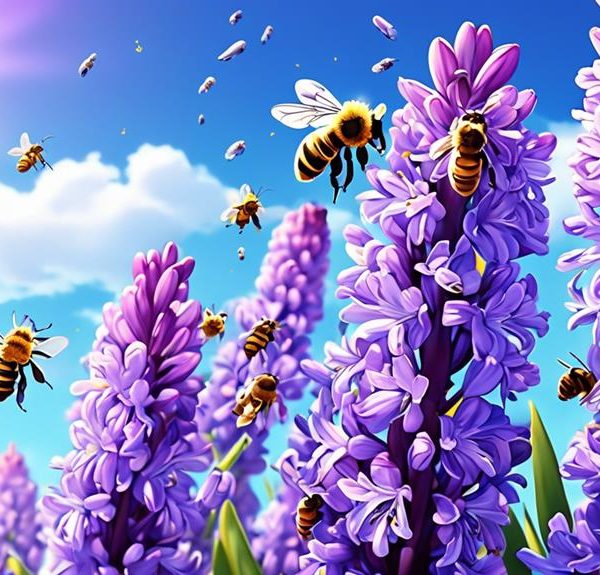Adore lilacs? So do bees! Discover the captivating bond between these buzzing pollinators and your favorite backyard blooms.

Do Bees Like Lilac?
Have you ever noticed how your backyard lilac bushes seem to buzz with life, particularly in the warmer months? It's not your imagination running wild.
The reality is, bees, those industrious little pollinators, are indeed drawn to lilac. But what is it about this particular plant species that makes it such a bee magnet? Is it the lilac's intoxicating scent, its vivid color, or something else entirely?
As you venture further into this mystery, you'll discover the intricate relationship between bees and lilacs, and how understanding this can transform your approach to gardening.
Key Takeaways
- Lilacs have attributes that attract bees, such as their enticing fragrance, vibrant colors, profuse bloom, and well-suited flower structure.
- The symbiotic relationship between bees and lilacs benefits both parties, with bees aiding in plant reproduction and lilacs providing bees with nectar and pollen.
- Planting lilacs in gardens can have a positive impact on garden ecosystems by attracting bees, promoting biodiversity, and enhancing cross-pollination.
- To encourage bee-friendly gardens, it is important to plant a variety of flowers that bloom at different times, avoid pesticides, introduce beneficial insects, and use organic pest control methods.
Understanding Bee Attraction to Flowers
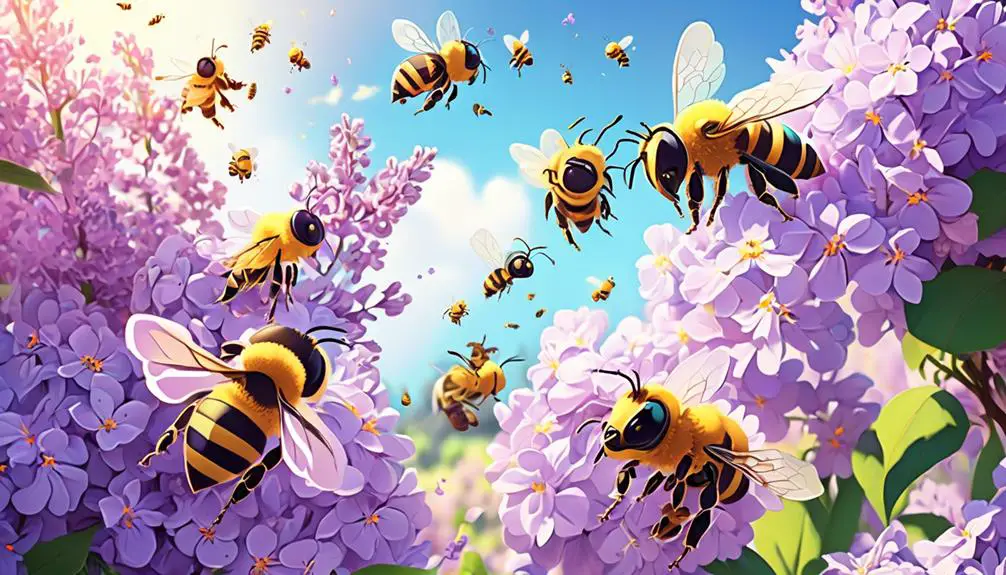
To grasp why bees might be attracted to lilac flowers, it's crucial to first understand the fundamental principles of bee-flower interactions and the factors that influence these relationships.
Bees, like all organisms, are driven by the need to survive and reproduce. Their attraction to flowers is primarily driven by the pursuit of nectar, a vital food source.
Flowers, on the other hand, use nectar as bait to lure bees. When bees visit for a nectar meal, they inadvertently pick up pollen, which they then transfer to other flowers, aiding in plant reproduction. This symbiotic relationship is influenced by several factors.
Firstly, the color and pattern of the flower play a significant role in attracting bees. Bees perceive color differently from humans; they're drawn to blue, purple, and yellow hues.
Secondly, the scent of a flower can attract or repel bees. Certain floral scents are particularly appealing to bees and can be detected from a distance.
Lastly, the shape and size of the flower can also affect bee visitation. Flowers that provide a landing platform, like lilacs, are often preferred.
Understanding these factors provides a basis for why bees might be attracted to lilac flowers.
The Unique Allure of Lilacs
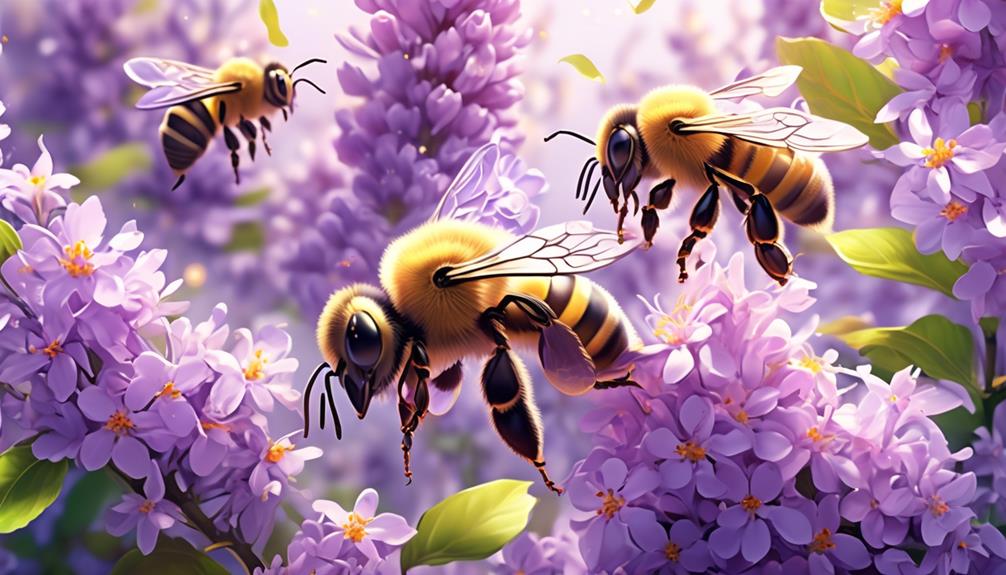
Having established the general principles of bee-flower interactions, let's now examine the specific attributes of lilacs that make them particularly alluring to bees.
Lilacs, belonging to the genus Syringa, possess an enticing fragrance, one that's not just attractive to our human senses but also to the olfactory receptors of bees. This scent, scientifically categorized as a volatile organic compound, is an effective chemical signal for bees in search of nectar.
You'll also notice that lilacs have a vibrant color spectrum ranging from white to deep purple. This color variety isn't a mere aesthetic feature. It's a strategic biological adaptation designed to attract pollinators. Bees perceive color differently than humans. Their vision is attuned towards the blue and ultraviolet end of the light spectrum. Lilacs' hues align perfectly with this visual preference.
In addition, lilacs have a profuse bloom, presenting bees with a generous offering of nectar and pollen. The structure of the lilac flower cluster, with its multitude of small, tubular blossoms, is ideally suited for the bee's body shape and foraging habits.
This combination of attributes – scent, color, bloom density and structure – makes lilacs an irresistible draw for bees.
Bees and Lilacs: A Symbiotic Relationship
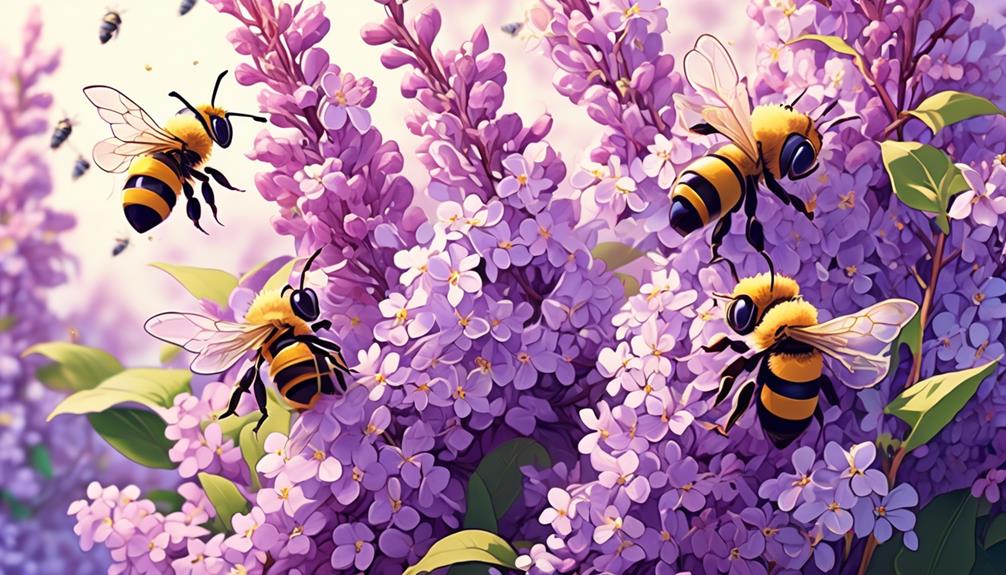
In the intricate dance of pollination, bees and lilacs share a mutually beneficial relationship, each species playing a crucial role in the other's survival and propagation. Consider the humble bee, buzzing from flower to flower, collecting nectar to produce honey. As it lands on each lilac bloom, it inadvertently picks up pollen, becoming a vital courier in the plant's reproduction process.
Now, let's examine the lilac. It's not passive in this relationship; it entices bees with vibrant colors and sweet nectar. Its pollen is strategically placed to attach to the bee's body, ensuring successful pollination.
This symbiosis isn't just about survival. It's about thriving. Lilacs rely on bees for cross-pollination, enhancing their genetic diversity and resilience. Bees, in turn, depend on lilacs' nectar as a food source and their pollen for honey production.
But there's a subtle twist. Bees' preference for lilac's nectar can shape the evolution of the plant's traits over time, favoring those that attract more pollinators. You see, it's a dance of co-evolution, where both partners influence each other's survival, growth, and even evolution.
Impact on Your Garden Ecosystem
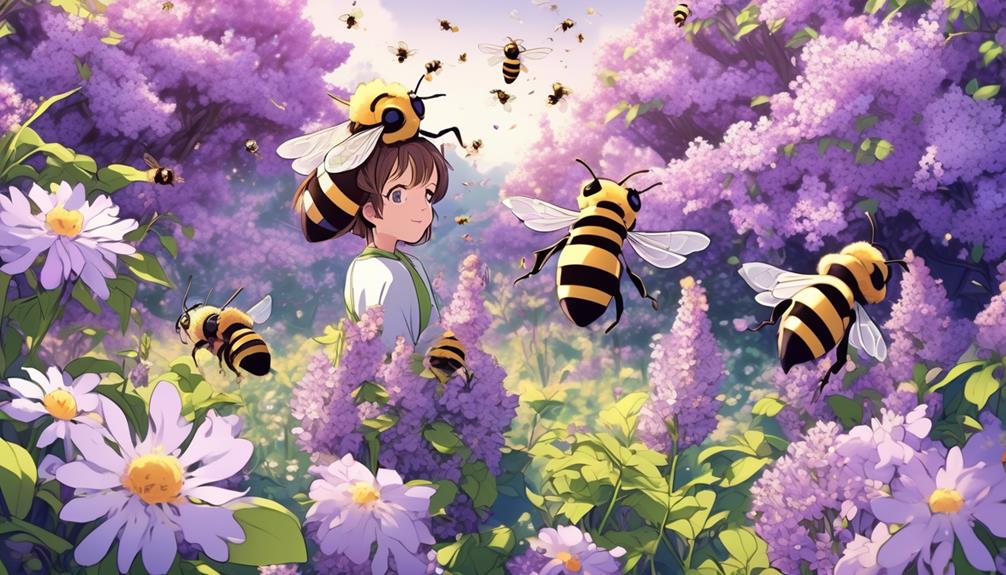
Planting lilacs in your garden significantly enhances your local ecosystem, attracting a multitude of bees that aid in pollination and boost biodiversity. The lilac's sweet, potent aroma is an irresistible beacon for bees, drawing them in droves. When bees visit your lilacs, they collect pollen on their bodies, spreading it from flower to flower as they forage. This cross-pollination process is critical for plant reproduction, ensuring a diverse, robust plant community in your garden.
But the impact goes beyond your garden's boundaries. The bees' pollination activity extends to neighboring plants, potentially increasing the productivity of local farms and orchards. Your garden, therefore, becomes a critical link in a larger ecological network.
Furthermore, lilacs are hardy and relatively low-maintenance, making them a sustainable choice for your garden. They're resilient to pests and diseases, reducing the need for chemical interventions that can harm beneficial insects, including bees. Hence, by choosing to plant lilacs, you're contributing to a healthier, more balanced ecosystem.
Tips for Encouraging Bee-Friendly Gardens
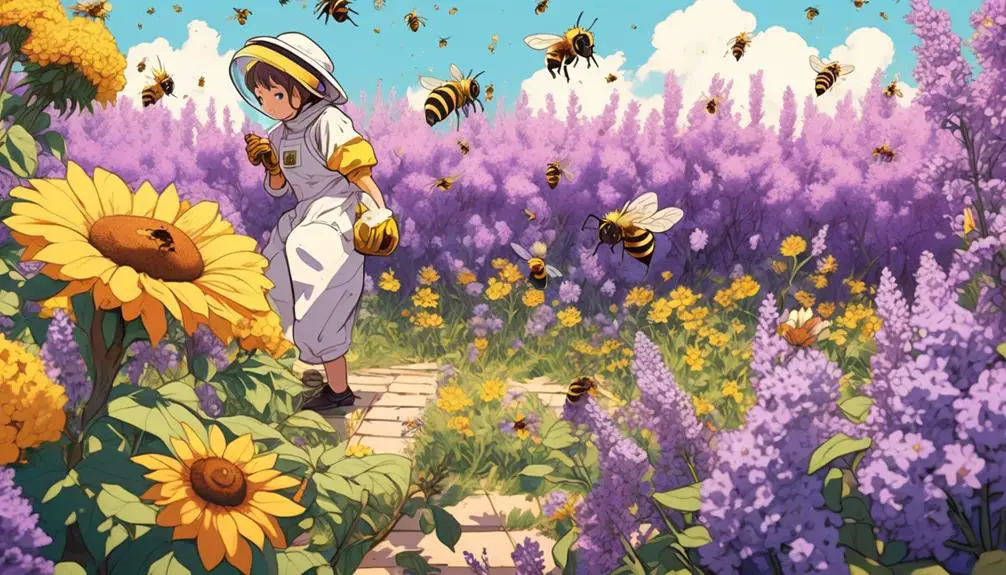
To make your garden a haven for bees, you'll often need to think beyond just planting bee-attracting plants like lilacs. Yes, bees do love lilacs, but they also need a variety of plants that bloom at different times of the year to have a consistent food source. Therefore, aim to have at least three different types of flowers blooming in your garden throughout the growing season.
Season | Suggested Plants |
|---|---|
Spring | Crocus, Hyacinth, Borage |
Summer | Bee Balm, Cosmos, Snapdragons |
Fall | Sedum, Asters, Witch Hazel |
Another essential aspect is the avoidance of pesticides. These chemicals can harm bees and other pollinators. Instead, consider natural methods of pest control, like introducing beneficial insects or using organic solutions.
Frequently Asked Questions
What Other Plants, Besides Lilacs, Are Particularly Attractive to Bees?
You're curious about which plants, aside from lilacs, are bee magnets.
Bees are particularly drawn to plants like lavender, sage, and sunflowers due to their bright colors and sweet nectar. They're also fond of fruit trees, such as apple and cherry, which offer abundant blossoms.
Herbs like mint and thyme, as well as wildflowers like poppies and daisies, also make the list.
How Does the Presence of Bees Affect Other Insects in the Garden?
Bees in your garden can impact other insects. They'll compete for nectar and pollen, reducing the availability for other bugs. However, they're also pollinators. As they travel from flower to flower, they're transferring pollen, aiding in plant reproduction.
This increases the overall health and diversity of your garden, benefitting all insects in the long run. So, while there's immediate competition, the presence of bees ultimately fosters a more vibrant insect ecosystem.
Can a Garden With Lilacs Attract Other Types of Pollinators Besides Bees?
Yes, your garden with lilacs can certainly attract other pollinators besides bees. Butterflies, moths, and hummingbirds are also drawn to the sweet scent of lilacs. These pollinators are vital for a healthy ecosystem, aiding in plant reproduction.
What Are Some Potential Risks to Bees in a Garden With Lilacs?
You're asking about potential risks to bees in a garden with lilacs.
Pesticides can pose a significant threat. If you're spraying your lilacs, you could harm the bees.
Also, lilacs bloom early in the season, so if there aren't enough diverse plants blooming later, bees might struggle to find food.
Lastly, in a monoculture garden, bees may face a lack of nutritional diversity, impacting their health.
Always aim for a variety of plants to support your local bees.
Are There Any Specific Types of Bees That Are More Attracted to Lilacs Than Others?
You're asking about specific types of bees attracted to lilacs more than others.
Well, generally, honey bees and bumble bees are highly attracted to lilacs. These bees are drawn to its potent fragrance and vibrant colors.
However, other types of bees might visit lilacs as well. It's important to note, the attraction can vary depending on the bee species' preferences and the availability of other flowers in the vicinity.
Conclusion
In conclusion, bees are truly enchanted by lilacs. Their vibrant colors and intoxicating scent make them irresistible to our striped friends.
This symbiotic relationship not only benefits the bees and lilacs but your garden's ecosystem as well. By encouraging bee-friendly gardens, you're promoting biodiversity and aiding in the survival of these crucial pollinators.
So, yes, bees definitely love lilacs, and it's a relationship we should all strive to foster.

